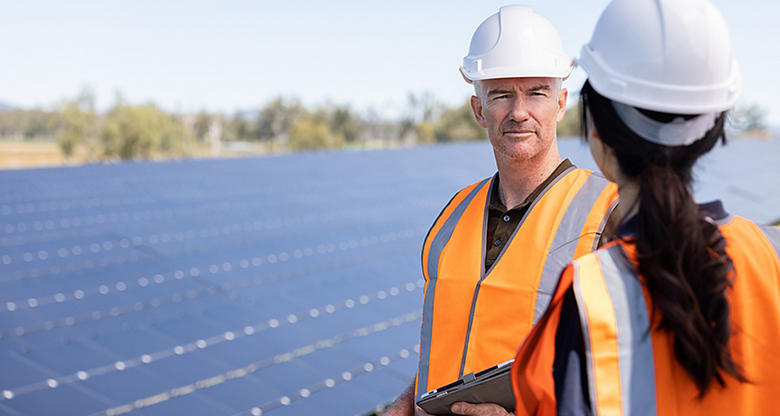Last year, more than 4.3 gigawatts of large-scale wind and solar projects were given the green light, according to Australia's Clean Energy Regulator, up 50 per cent compared to 2021.
This period saw renewable energy assets meet an average 35 per cent of demand across the National Electricity Market, spiking to more than 40 per cent in the fourth quarter.
But growth is just part of the story, according to Neil Fraser, CBA's Executive Director of Natural Resources and Energy. There's also been a shift in the way renewable energy assets are financed.
In the past, project developers funded the construction and operation of renewable energy projects with asset-level finance, Fraser says, essentially applying for individual loans on every project. As the sector matured, some developers operated multiple assets backed by individual loans.
For Fraser, this means the sector is ripe for consolidation, where owners can seek to finance an entire portfolio of renewable energy projects, rather than a set of assets backed by individual loans.
"Developing new solar and wind farms could be easier with portfolio financing because lenders might be more open to leveraging cash flow from existing assets to support adding new ones to the portfolio," Fraser says.
This approach offers diversification for both owners and lenders.
"For example, if it's raining on the Mornington Peninsula but sunny in Brisbane, having renewable assets in both locations mitigates exposure to resource, operational and merchant risks," Fraser says.
Tilt Renewables Interim Chief Executive Steve Symons says portfolio-level funding is one of the factors helping renewable energy owners and operators consolidate and capitalise on scale.
"Portfolio financing is definitely an advantage," Symons says. "We're seeing a number of groups who are owners of multiple assets now moving to portfolio type financing."
"It is still, to an extent, project financing principles across multiple assets. But what it does is it enables the cash flows of all assets to be aggregated such that if one asset is having performance issues that the other assets are then able to support those assets."
In 2021, Tilt Renewables was purchased by Powering Australian Renewables (PowAR), a strategic partnership between AGL, The Future Fund and QIC.
At the time, PowAR possessed a number of assets, individually financed on an asset level.
"Tilt Renewables had a portfolio from the time it was created in 2017 through to when it was acquired by PARF, and were one of the first ones to do that back in 2017," Symons says. "So it made sense then, when the two businesses came together for all those assets to come together under the one portfolio."
Symons says portfolio-level financing can help owners and operators realise growth opportunities.
"It's the speed of the ability to be able to bring new projects to market to close. You're not needing to renegotiate all the terms of your financing documents. The financing documents are there, they're set up, they've got principles, or the way in which new projects are brought in," Symons says. "And then you just work through those principles. And it gives that flexibility for continued growth."
It's a similar story for Squadron Energy, which purchased the entire renewables portfolio of CWP Renewables last year, the largest-ever acquisition in Australia's renewable energy sector.
"We have 1.1 gigawatts of renewable energy in operation and an Australian development pipeline of 20 gigawatts which includes a combination of wind, solar, batteries and firming assets," Squadron Energy Chief Executive Jason Willoughby says.
"The scale of this pipeline, together with our market leading portfolio-level debt financing, allows us to provide the firmed renewables necessary to lead Australia's energy transition."
Fraser acknowledges the complexities of shifting from single-asset loans to portfolio-level financing and says banks require a sophisticated approach to risk assessment, revenue forecasting and valuation.
"When you're looking at multiple assets across several geographies, there are a lot more moving parts to consider," Fraser says. "For CBA, our strong project financing and industry sector experience provides clients with the confidence to execute these complex transactions."
"We play a key role in the debt structuring, deal documentation, and assessment of due diligence to support the transactions – all of which are more complex for a portfolio. We structure transactions that satisfy our risk criteria whilst also meeting the strategy and objectives of a growing portfolio."
With five different portfolio financings completed in the first half of the year, Fraser expects further portfolio formation over the next 18 months, albeit at a slower rate than witnessed in the first half of 2023.
The year to date has been one of the slowest markets for new renewable generation assets reaching financial close. However, there is a lot of development activity underway with a long pipeline of assets. Having flexible financing structures offered through portfolio financings will play a role in accelerating some of these assets from development and into construction.
"Inflation and constrained transmission capacity has taken a toll on the industry this year, resulting in a very slow market for new renewable generation assets reaching financial close. However, there is a lot of development activity underway with a long pipeline of assets. Portfolio financings – and the flexibility they offer developers - will play a role in accelerating some of these assets from development and into construction," Fraser said.
This article was originally published in The Australian (News Corp) on 27th October 2023.

